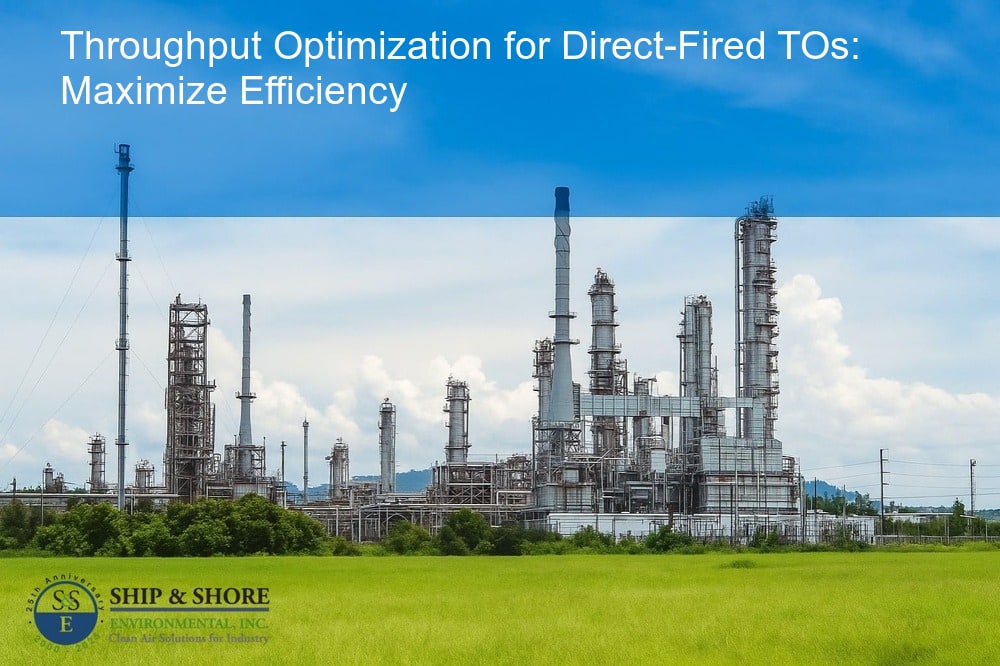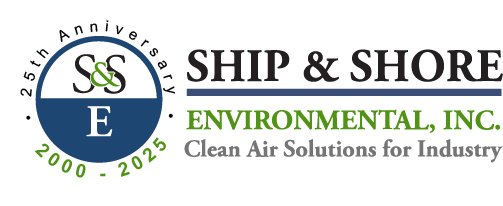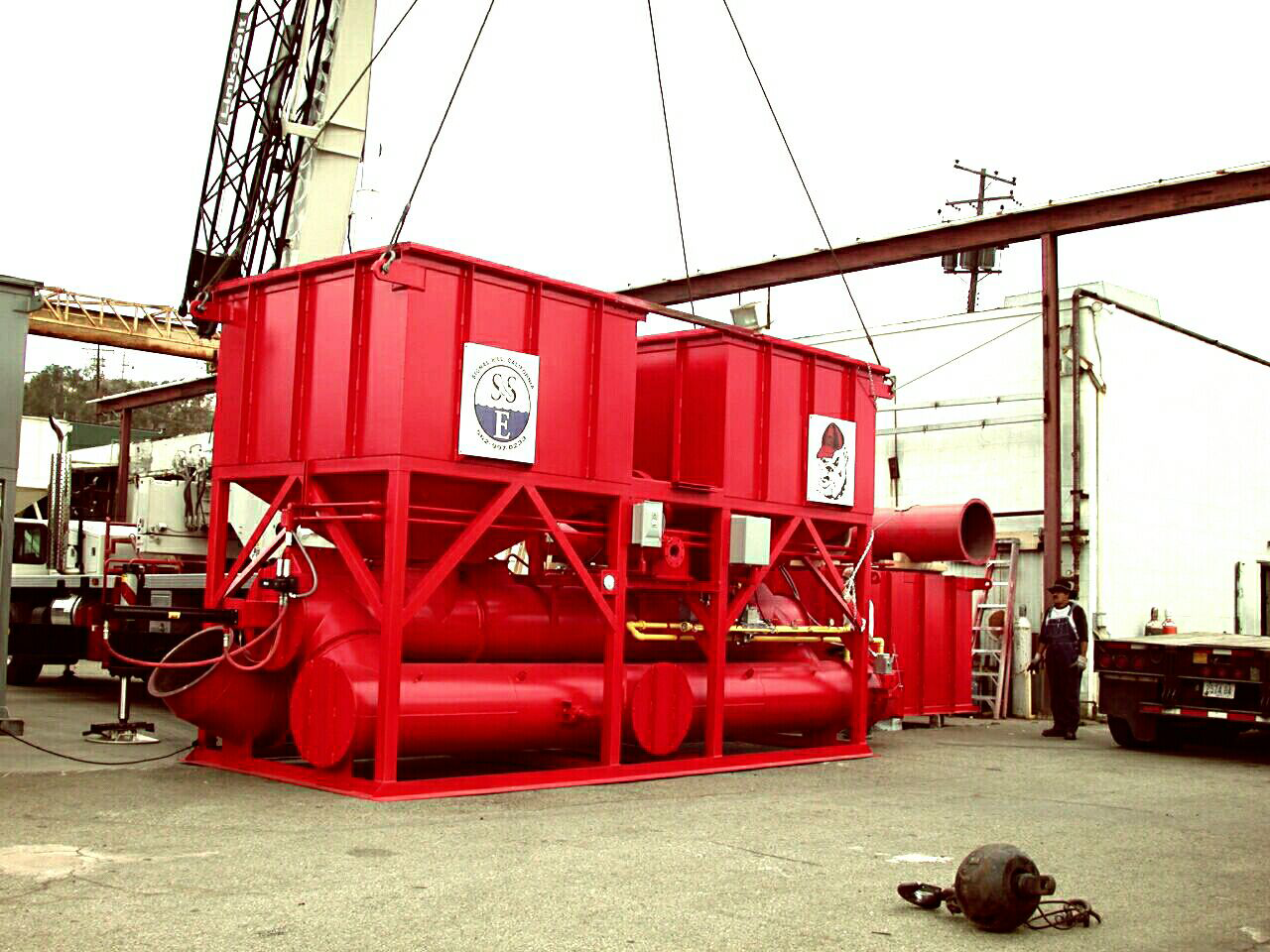
Advancing Efficiency: Throughput Optimization for Direct-Fired TOs
June 20, 2025 5:42 amUnderstanding Direct-Fired Thermal Oxidizers: The Basics
At Ship & Shore Environmental, Inc., maximizing efficiency is always a prime focus, and throughput optimization for direct-fired TOs is a crucial element in this pursuit. Direct-fired thermal oxidizers (TOs) are essential for controlling air pollution by decomposing hazardous gases through combustion. These devices are commonly used in various industries, including chemical processing, pharmaceuticals, and waste management, to ensure that harmful emissions are reduced to safe levels. In essence, direct-fired TOs use heat to break down volatile organic compounds (VOCs) and other pollutants into inert byproducts like carbon dioxide and water.
The Critical Role of Throughput in Direct-Fired TOs
Throughput refers to the amount of material processed by the thermal oxidizer within a given time frame. High throughput often translates to increased production and efficiency, making it a critical factor in operational performance. In direct-fired TOs, optimizing throughput means that more pollutants can be processed in a shorter amount of time, significantly improving the viability of the entire operation. By focusing on throughput optimization for direct-fired TOs, companies can achieve better combustion efficiency, lower energy consumption, and reduced operational costs. Additionally, optimal throughput ensures regulatory compliance by maintaining the necessary standards for emissions control.
Introduction to the Concept of Throughput Optimization for Direct-Fired TOs
Throughput optimization for direct-fired TOs is a multi-faceted approach that involves various strategies and technologies. From upgrading hardware components to implementing advanced control systems, there are numerous ways to enhance the throughput of direct-fired TOs. The goal is to ensure that the oxidizer operates at its peak performance, efficiently decomposing pollutants while minimizing energy usage and operational costs. This is particularly important in today’s competitive landscape, where sustainability and cost-efficiency are more crucial than ever. At Ship & Shore Environmental, Inc., we are committed to providing state-of-the-art solutions that help our clients maximize their throughput and overall efficiency.
Understanding Throughput Optimization: Breaking Down the Process
Throughput optimization for direct-fired TOs involves fine-tuning various operational parameters to maximize the volume of waste gases processed efficiently. Initially, assessing the current performance metrics provides the baseline data. From there, we evaluate key factors such as combustion efficiency, residence time, and airflow patterns. By focusing on these critical aspects, we can identify areas for potential improvement.
Additionally, implementing advanced monitoring systems enables real-time adjustments and helps us maintain optimal conditions. This not only maximizes throughput but also ensures compliance with environmental regulations. Furthermore, periodic maintenance checks and timely upgrades can significantly enhance the performance of direct-fired TOs.
The Impact of Throughput Optimization on Direct-Fired TOs
Optimizing throughput directly impacts several facets of our operations. First and foremost, it leads to a notable increase in the efficiency of waste gas processing. Consequently, we can manage higher volumes of emissions without compromising on the pollutant destruction rate.
Moreover, throughput optimization translates to reduced operational costs. Efficient systems consume less fuel, which lowers energy expenses. Additionally, streamlined processes reduce wear and tear on equipment, cutting down maintenance costs and extending the lifespan of our thermal oxidizers.
Another significant benefit is the enhanced ability to meet and exceed regulatory standards. Optimized systems ensure consistent performance, helping us stay ahead of compliance requirements. Ultimately, this bolsters our reputation as an industry leader in environmental solutions.
Real-World Application: Case Studies of Successful Throughput Optimization for Direct-Fired TOs
Examining real-world scenarios, we can highlight several instances where throughput optimization for direct-fired TOs has yielded exceptional results. One notable case involved a manufacturing plant struggling with emission compliance due to aging equipment. By implementing a comprehensive optimization strategy, including the installation of advanced monitoring systems and regular maintenance, the plant achieved a 30% increase in throughput while significantly reducing fuel consumption.
In another instance, a chemical processing facility faced challenges with fluctuating production demands. Through a tailored approach that included dynamic airflow control and precise combustion tuning, we were able to stabilize their operations. This not only enhanced throughput but also ensured consistent pollutant destruction across varying production levels.
- Increased operational efficiency
- Reduced fuel and maintenance costs
- Enhanced regulatory compliance
- Prolonged equipment lifespan
- Improved environmental performance
These case studies underscore the transformative impact of effective throughput optimization, demonstrating tangible benefits that extend beyond mere operational improvements. As the demand for efficient and sustainable environmental solutions continues to grow, optimizing throughput in direct-fired TOs remains a vital lever for enhancing overall performance.
Did you know: Throughput optimization in Direct-Fired Thermal Oxidizers can significantly reduce fuel consumption and emissions, leading to enhanced operational efficiency and environmental sustainability.
Future Implications: The Potential of Throughput Optimization for Direct-Fired TOs
As we look ahead, the potential of throughput optimization for direct-fired TOs (Thermal Oxidizers) cannot be overstated. Our industry continually evolves, seeking innovative ways to enhance efficiency and sustainability. This optimization is poised to play a pivotal role in achieving these goals. By maximizing the throughput, we can significantly reduce emissions and operational costs while improving overall performance.
Achieving Greater Operational Efficiency through Throughput Optimization
Throughput optimization is not just a theoretical concept but a vital practice that can yield tangible results. By focusing on this optimization, we can enhance the performance of direct-fired TOs, ensuring they operate at peak efficiency. This involves fine-tuning various process parameters, such as temperature control, fuel usage, and residence time, to achieve the best possible outcomes. The benefits are manifold, including reduced downtime, lower fuel consumption, and extended equipment lifespan.
Final Thoughts: The Long-Term Viability and Sustainability of Throughput Optimization for Direct-Fired TOs
The long-term viability and sustainability of throughput optimization for direct-fired TOs are promising. By embracing these optimization practices, we are not only improving our current operations but also setting a solid foundation for the future. The lessons learned from successful case studies demonstrate the real-world applicability and benefits of these optimizations. As we continue to innovate and refine our processes, the prospects for achieving greater efficiency and reduced environmental impact are brighter than ever.
FAQ
What is throughput optimization for direct-fired thermal oxidizers?
Throughput optimization in the context of direct-fired thermal oxidizers (TOs) involves enhancing the process efficiency and operational capabilities of the TOs. It refers to the process of adjusting operational variables, such as temperature and fuel usage, to increase the amount of waste processed without compromising on environmental or safety standards. This process aims to enable our equipment to handle greater volumes with improved performance, ensuring that we meet our throughput goals efficiently.
How does throughput optimization benefit our operations?
By optimizing throughput, we create several advantages for our operations. Firstly, it allows us to process larger quantities of waste more efficiently, leading to increased productivity. Additionally, it aids in reducing fuel consumption and operational costs, as the process becomes more efficient. Moreover, optimizing throughput has the added benefit of reducing the downtime of equipment, extending the lifespan of our direct-fired TOs, and minimizing our environmental impact by decreasing emissions.
What are some common strategies for optimizing throughput in direct-fired TOs?
Common strategies include precision control of the combustion temperature, optimizing fuel-to-air ratios, and ensuring consistent waste feed rates. Furthermore, regular maintenance to prevent and address operational bottlenecks, as well as the use of advanced sensors and control systems, are vital. Additionally, retrofitting older equipment with updated technology can significantly enhance throughput efficiency. Our continuous improvement practices ensure that we examine and implement the most effective strategies tailored to each TO’s specific requirements.
Can throughput optimization affect the long-term sustainability of our TO operations?
Absolutely, optimizing throughput can significantly contribute to the long-term sustainability of our operations. By enhancing efficiency and productivity while reducing waste and emissions, we promote a more sustainable operation model that can adapt to changing regulations and market demands. As a result, we can ensure that our direct-fired TOs remain viable and environmentally responsible solutions for years to come.
What role does technological innovation play in throughput optimization?
Technological innovation is at the heart of throughput optimization. With advancements in control systems, analytical tools, and process equipment, we have unprecedented opportunities to fine-tune our operations. Consequently, these innovations allow us to monitor and adjust parameters in real-time, predict maintenance needs, and improve the reliability and efficiency of our direct-fired TOs. Embracing these cutting-edge technologies ensures that we stay at the forefront of our industry, offering optimized, state-of-the-art solutions for waste processing and emissions control.
Categorised in: Blog

